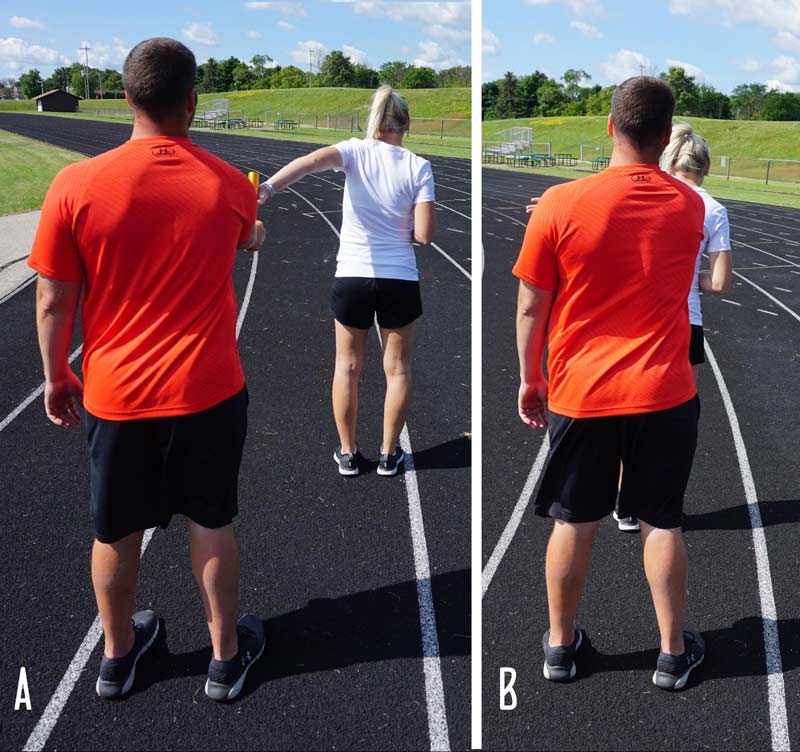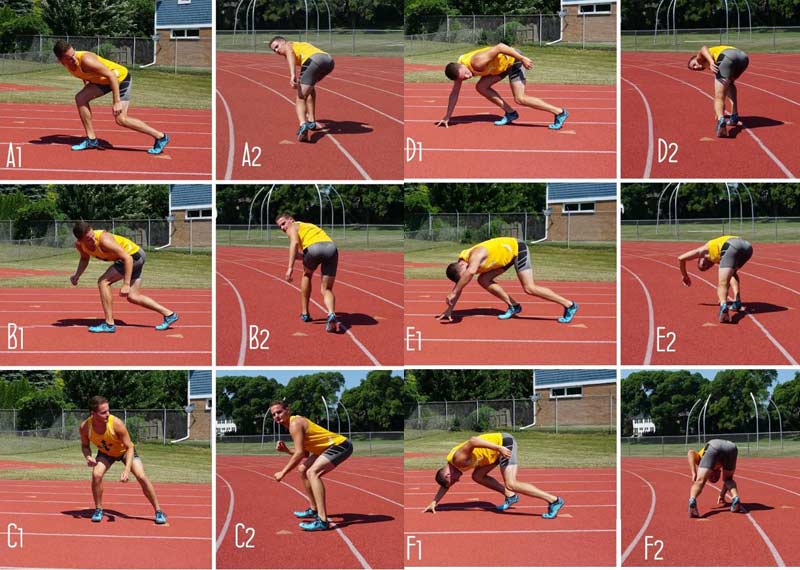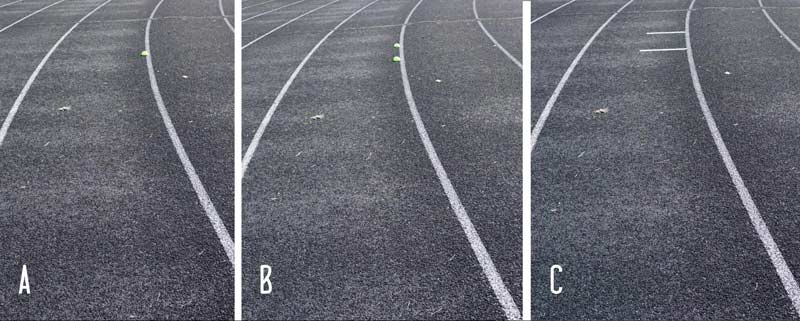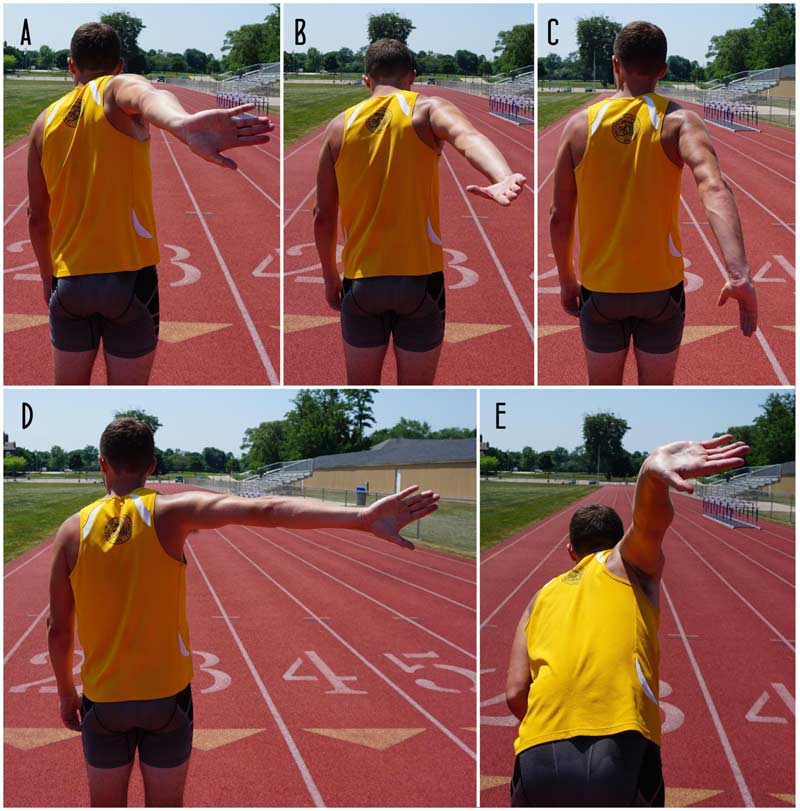

This text is designed to be a one-stop store for teaching the 4x200m relay. We is not going to delve into power methods or particular coaching methods for the 200m sprint however will as an alternative deal with the distinctive facets of the 4x200m relay (particularly practising the handoffs). Hopefully, there’s sufficient right here for the start coach to get a grasp on the occasion whereas additionally introducing some new parts to assist skilled coaches.
I. Why Is the 4x200m Relay Distinctive?
Allow us to be brutally sincere right here: the 4x200m relay is commonly seen as a B-team relay, particularly till the championship season begins. The 4x100m, 4x400m, and 4x800m relays get considerably extra glory throughout many of the yr. That is partially as a result of many states didn’t even compete a 4x200m relay at their championship collection till this millennium. Some nonetheless don’t compete a 4x200m at State.
Another excuse the 4x200m relay is an afterthought is as a result of it’s crammed proper in the midst of the meet. In Illinois, the 4x800m and 4x100m relays are the primary two working occasions, and the 4x400m relay, in fact, ends every meet. The 4x200m relay is caught proper within the center, with the 400m sprint and 300m hurdles coming proper after it. That pulls out lots of people who would probably be working on a staff’s A 4x200m relay.
Illinois permits athletes to compete in 4 working occasions, which implies you’ll usually see athletes competing within the 4x100m, 100m, 4x200m, and 200m. However in some states (like Wisconsin), athletes are restricted to simply three working occasions. That pulls a variety of athletes out of the 4x200m relay, particularly if you think about athletes working the 300m hurdles, 400m sprint, and 4x400m relay. Moreover, coaches have gotten extra conscious of not overloading athletes earlier than the championship meets, which implies limiting occasions. The 4x200m relay is commonly the primary occasion dropped from a prime athlete’s docket.
Regardless of all the issues with the 4x200m relay being troublesome to load through the season, one reality stays: the 4x200m nonetheless counts for a similar variety of factors because the 4x100m, 4x400m, and 4x800m.
Video 1: When you’ve got by no means seen a 4x200m relay earlier than, it’s fairly a spectacle. Because the race is run in lanes your complete time, the opening stagger is big. There are a selection of handoff strategies, lineup choices, and race methods to think about.
II. What’s Nice Concerning the 4x200m Relay?
One nice advantage of the 4x200m relay early within the season is offering these “B-team” athletes with an opportunity to get varsity expertise. In 2016, we had a fantastic dash crew and didn’t totally load our A 4x200m relay till the Sectional Championships. We had 9 athletes win outside invitationals for us within the 4x200m relay that yr.
As a coach, so as so that you can make this relay an essential breeding floor for fulfillment through the season, you must deal with the 4x200m like an A relay. Attitudes are contagious, so although I’ve spent the vast majority of this text up to now telling you why the 4x200m relay doesn’t get respect, it’s worthwhile to be sure you emphasize and prioritize it.
III. Selecting a Lineup
The 4x200m relay is just not fairly as sophisticated because the 4x100m relay, and your 4 greatest obtainable 200m runners will virtually all the time find yourself in your 4x200m relay A staff. In contrast to the 4x100m relay, the place you ideally need to persist with the identical 4 athletes all yr, switching up the 4x200m relay is far simpler.
It is a distinctive dash relay within the sense that each athlete runs virtually the identical leg. In a 4x100m relay, some athletes run curves whereas others run straightaways, and a few athletes run with the baton of their left hand and others of their proper hand. Within the 4x400m relay, the leadoff is in lanes the entire time, the second leg has to chop in, and the third and fourth legs should fear about catching a baton in visitors. However within the 4x200m relay, each athlete runs a nook and a straightaway of their lane the entire time.
There are some distinctive facets to the 4x200m that make selecting a lineup crucial. The obvious is that the leadoff athlete comes out of blocks, so it’s best to intention to place a very good starter on that leg. Nonetheless, I consider that is the relay the place getting a lead early is least essential.
I believe the 4x200m relay is the relay where getting a lead early is least important, says @LFHStrack. Click To Tweet
Within the 4x100m relay, the stagger is so small that athletes can gauge their place early on, so having a lead provides a psychological benefit. Within the 4x400m and 4x800m relays, getting a lead early is essential to make the handoffs simpler. However within the 4x200m relay, the race is run in lanes with such an enormous stagger, and the handoff zone is so massive (30 meters) that the majority athletes can not inform the place their place is early within the race. The psychological benefit is far decrease. Ideally, you’ll have your leadoff get you in first place, however that’s not as important as it’s within the different relays.

The primary distinction within the leadoff leg is the massive, considerably ridiculous stagger. If you run a 200m, you anticipate to have about 100 meters on a curve after which 100 meters on a straightaway. Nonetheless, the leadoff runners within the outdoors lanes can find yourself working about 35 meters on a curve, 100 meters on a straightaway, after which one other 65 meters on the curve. This makes the race troublesome to method strategically. The later you get within the legs, the extra the ratio “evens out” and the extra much like an everyday 200m race you get. When you’ve got an athlete who has hassle with race modeling, for no matter motive, put them on the later legs.
If you happen to select to not change palms with the baton, you’ll have to take into account which hand the athletes are snug carrying the baton in. The usual is that the leadoff and third runners carry the baton of their proper hand, the second leg carries it of their left, and the anchor leg catches it left and might select whether or not or to not change it to their proper hand. Nonetheless, as a result of all of the athletes will run a nook and a straightaway, you might be far more versatile.
For instance, your leadoff can run with the baton within the left hand with none situation. You may even have some athletes change palms and others not. However no matter you select to do, the athletes should be fully conscious throughout follow and positively earlier than the race begins.
IV. Handoffs
With out query, the 4x200m relay handoffs are probably the most sophisticated. Aside from the baton place, 4x100m relay handoffs are fairly standardized and comparatively simple to follow. Handoffs for the 4x400m and 4x800m relays are open and comparatively simple to follow and execute. Nonetheless, there are numerous choices for 4x200m relay handoffs, and plenty of of them are extraordinarily troublesome to follow (as a result of elements we’ll talk about). First, let’s speak concerning the givens.
Lane Self-discipline
Always and in all races, lane self-discipline should be maintained. Merely put, the athletes want to go away sufficient area within the lane so that they don’t tangle up their legs with each other. The final rule is that the baton all the time stays in the midst of the lane. So, if the incoming runner has the baton of their proper hand, they are going to be on the within of the lane; this implies the outgoing runner will obtain the baton of their left hand and be on the surface of the lane. Whatever the fashion of handoffs you carry out, it’s worthwhile to comply with lane self-discipline.

Handing Off within the Zone
The brand new 30-meter change zone simplifies handoffs as a result of athletes not want to fret about handing off too early. The expanded change zone additionally provides the opportunity of extending sure legs. Theoretically, the center runners (second and third legs) may run a 230-meter leg in the event that they caught the baton on the very starting of the zone and handed it off on the very finish.
Handing off on the very finish is dangerous, in fact, and no one catches it on the very starting except there’s a downside. Nonetheless, a artful coach may positively manipulate the zones a bit to get the quickest athletes the baton for longer whereas minimizing the baton time of the slower athletes. In a race usually received by hundredths of a second, this could possibly be the distinction between profitable and dropping.
On the 2022 Sectional Championships, our 4x200m relay staff had two athletes who had been a step above our different two. We put one of many studs on the second leg and our quickest athlete on the anchor leg. These two athletes began on the very again of the zone, whereas our third leg began about 15 steps forward. This prolonged the space our two studs needed to race with the baton and, due to this fact, shortened the space of our different two athletes. The technique labored as we beat the qualifying time by simply 0.19 seconds.
Word additionally that the athletes should begin inside the zone. They can’t have any a part of their physique make contact with the monitor outdoors the start of the zone. For a authorized handoff, the baton should be handed inside the zone. Which means that it’s doable that the outgoing runner’s toes can be outdoors the zone, however the baton is handed inside the zone, and the handoff is authorized. The baton is what counts, not the runner.
Now let’s get into a few of the choices you’ve gotten when practising and finishing 4x200m relay handoffs, so as.
Stance
When selecting a stance, the outgoing athlete must be ready to dash and see the incoming runner. All of the stances proven in picture 3 accomplish that job; nonetheless, I have to advise in opposition to selecting stance C as a result of butt interference. Please, please, please don’t train your athletes this stance. In reality, actively encourage your athletes to keep away from it.
Firm ground contact will not only allow the athlete to be faster out of the stance but also will increase consistency, says @LFHStrack. Click To Tweet
For highschool athletes, I like to recommend stance A. It’s versatile, easy, and applicable for the pace of highschool athletes. Whatever the stance you select, a fantastic piece of recommendation for the athletes is to make agency contact with the monitor with each toes as they get into their stance. Some athletes are jittery and bounce round a bit; others are extra timid and can solely have gentle contact with the monitor because the incoming runner approaches. The bottom contact must be agency, simply as if the athlete was placing stress on the beginning blocks. Agency contact is not going to solely enable the athlete to be sooner out of the stance but in addition will enhance consistency.

“Go” Marks
Because the timing of the 4x200m relay handoff is crucial, utilizing a “go” mark is crucial. The mark gives a visible cue for the outgoing runners to begin their acceleration. You may both have the outgoing runner anticipate when the incoming runner will hit the mark, or you possibly can have the outgoing runner start acceleration after they see the incoming runner hit the mark.
Although there are numerous objects you need to use as a go mark (in a pinch, I’ve seen athletes use dandelions and even their very own spit), the usual objects are a tennis ball reduce in half or a bit of athletic tape. Sure tracks and competitions have guidelines for what’s allowed, so make sure you recognize going right into a meet what marks can be found. Most highschool meets enable tennis balls or chalk marks, whereas most school meets enable tape. Picture 4 exhibits what a few of these marks seem like from the outgoing runner’s viewpoint.

One choice you must make as a coach is whether or not to make use of one mark or two. When utilizing two marks, the athletes take a look at a zone versus a single mark. Usually, this zone is 3–5 steps lengthy. When utilizing a zone, the outgoing runner goes when the incoming runner steps into the zone.
As a coach, I’ve my athletes use one mark as a result of that provides the outgoing athletes just one object to deal with as an alternative of two.
One decision you have to make as a coach is whether to use one ‘go’ mark or two. When using two marks, the athletes look at a zone versus a single mark, says @LFHStrack. Click To Tweet
If you happen to select to make use of tennis balls to your go marks, all the time maintain lots readily available. I recommend going to the tennis coach and asking for all of the outdated tennis balls they’re completed utilizing. Minimize them in half, draw your staff emblem on them with a marker, and maintain no less than two dozen readily available at follow. Give one to the athletes who persistently want them at meets, and maintain lots in your teaching bag. An athlete scampering round earlier than a race looking for a tennis ball is just not within the frame of mind you need heading into an essential race.
Another choice is to make use of the change zone itself as your go mark. As a result of massive zone (30 meters), you won’t need each athlete beginning on the very starting of the zone. So you possibly can have your athletes use the mark for the change zone itself as their go mark. See video 2 for an instance of the right way to use the zone or an object as your go mark.

Video 2: Utilizing the change zone as your go mark versus utilizing an object as your go mark. Discover additionally that the athletes should begin contained in the zone. In each examples, you’ll discover he makes use of 15 steps.
Steps
After you have discovered the place to begin and what to make use of as your go mark, you should work out what number of steps to place between the 2. These steps are normally measured by having the athletes mark them off heel-to-toe (see video 2). Usually, the sooner the incoming athlete, the extra steps it’s worthwhile to take. We normally begin the season with everybody utilizing 13 steps and regulate from there. By the top of the season, most of our varsity athletes are utilizing 15–16 steps.
Whereas the variety of steps largely will depend on the pace of the incoming runner, there are a number of different elements in play. One is the pace of takeoff (which I’ll cowl within the subsequent part), and one other is the way you select to make use of the go mark. If you happen to select to have your outgoing runners anticipate the incoming runner hitting the go mark, then they are going to use a comparatively low variety of steps (12–16); when you select to have your outgoing runners begin acceleration as quickly as they see the incoming runner hit the go mark, they are going to use a comparatively excessive variety of steps (16–20).
Velocity of Takeoff
One of the vital troublesome choices it’s worthwhile to make is how briskly the outgoing runner wants to begin off. The final precept is to match the pace of the incoming runner. That is pretty simple within the 4x400m and 4x800m relays and in addition comparatively simple within the 4x100m relay as a result of just about each outgoing runner begins off at 100%. There may be some subtlety to the pace of takeoff within the 4x200m relay, with little margin for error, which makes it an especially essential talent.
One possibility is to begin as quick as doable, similar to within the 4x100m relay. Nonetheless, there are two potential downsides to this technique:
- Sprinting at prime pace makes it very simple to run away from the incoming runner, who’s fatigued and dropping pace.
- The steps will should be shortened because of the elevated pace of takeoff, which implies the incoming runner can be fairly near the outgoing runner because the outgoing runner takes off. This naturally triggers a “protection mechanism” whereby the incoming runner slows down for concern of working into the outgoing runner.
As a result of problematic nature of this technique, I don’t advocate the outgoing runner beginning off at 100% within the 4x200m relay. As an alternative, I like to recommend the runners begin off round 80%–90% of their prime pace. This isn’t a fool-proof technique, nonetheless. Highschool athletes notoriously battle with estimating their perceived pace. Inform them to run a 32-second 200m rep; some will run 26 seconds whereas others will run 38 seconds.
If you happen to inform your athletes to exit at 85%, they are going to seemingly carry out effectively in follow the place there’s minimal stress. Nonetheless, when the stress is on in a meet, those self same athletes may fall again on one excessive or one other. Nearly each coach has tales of athletes who both begin means too quick or means too gradual when the stress is on.
This is the reason follow makes good. The extra follow the athletes get with the correct takeoff pace, the extra ready they are going to be in meet conditions.
One other method to reinforce this delicate takeoff pace is to implement it in follow conditions outdoors of particular handoff work. For instance, when you do submaximal repeats, you possibly can instruct your athletes to begin on the similar pace (85%) on each rep. That means, if you describe what you search for within the 4x200m relay takeoff pace, you possibly can say it’s the similar takeoff pace as your submaximal reps.
Instructions
If you happen to do blind handoffs for the 4x200m relay, you should arrange instructions. For a verbal command, the incoming runners will yell out Stick! when they’re prepared at hand off the baton. Your athletes can yell out no matter they need, however Stick! appears to be the consensus.
The timing of this command is crucial, as many learners yell too late when somewhat anticipation is required. Right your athletes in follow in the event that they yell the command too quickly or too late. I ask my athletes to yell the command after they really feel they’re two arm lengths away from their teammate.
The timing of the handoff command is critical. I ask my athletes to yell the command when they feel they are two arm lengths away from their teammate, says @LFHStrack. Click To Tweet
An essential phrase to recollect with blind handoffs is Command-Hand-Attain. That is the order of execution for the incoming runner:
- Yell the command.
- See the goal hand.
- Attain with the baton.
Too usually, incoming runners attain earlier than they see the goal hand and generally earlier than they even yell the command. It’s so essential for the incoming runner to see the goal earlier than reaching for it with the baton. For one, most runners naturally begin slowing down a bit after they attain out with the baton. Preserve the arms pumping to maintain your pace up. Take a look at picture 5 to see the incoming runner’s arms nonetheless pumping because the outgoing runner provides the goal.
Reaching too quickly will increase the prospect that the outgoing runner will knock the baton out of the incoming runner’s hand. So bear in mind: Command-Hand-Attain!

Another choice is silent exchanges. A standard technique is to have the outgoing runners take six steps after which throw their palms again.
There are positives and negatives to each the verbal and silent exchanges. Many coaches who swear by the silent exchanges inform me they’re nervous their outgoing runners must decide their teammate’s voice out of a crowd of eight athletes yelling Stick! on the similar time. That could be a sound level, however in my 20 years of teaching monitor, I’ve by no means as soon as had a child inform me, “I couldn’t hear him say Stick!” If that ever did occur, possibly I’d change my technique, however for now, my athletes use verbal instructions on blind handoffs.
Additionally it is essential to notice the instructions required if the outgoing runner takes off too early. You want these instructions whether or not you might be executing a verbal or silent change. Incoming runners who consider they won’t catch their teammates ought to yell Gradual! which, in fact, means the outgoing runner ought to maintain working however decelerate. If the outgoing runner goes out means too early or the outgoing runner is nearly on the finish of the zone, the incoming runner ought to yell Cease!
Some coaches train their outgoing runners to peek over their shoulder in the event that they hear the command to gradual or cease to allow them to gauge the place their teammate is and execute a greater change. Whereas this actually helps in lots of conditions, one predominant downside is that athletes who peek over their shoulders will virtually actually transfer their goal hand.
If you happen to use open handoffs, you do not want to fret about instructions. One advantage of open handoffs is that they restrict the danger inherent in blind handoffs. Open handoffs are usually seen as slower than blind handoffs, however when you follow them persistently, the advantages can outweigh the negatives. Beginning off too early or too quick might be demise with blind handoffs however solely requires a minor adjustment with open handoffs.
Video 3. Blind handoffs vs. open handoffs: The primary handoff additionally exhibits a fantastic instance of Command-Hand-Attain.
Hand Placement
You may have the quickest athletes who comply with lane self-discipline and take off on the proper time, however that would all be for naught with out correct hand placement. No matter which hand placement you decide, the primary precedence is to maintain a gentle goal. A transferring goal is far more durable to hit than a stationary goal, so that you need your outgoing runner to offer a goal that’s regular and simple to see. Picture 6 exhibits quite a lot of totally different hand placements.

The cease signal methodology (A) is probably the most fascinating due to the massive goal it presents. Many athletes with decrease joint flexibility could have to flex their elbows greater than the athlete in picture 6. Variations of the cease signal embody D and E. Some coaches select D as a result of it’s a extra pure place—you possibly can see the athlete is just not as crunched up in his shoulders. Nonetheless, I’ve discovered that as a result of the shoulder in place D is just not in a pure working place, the primary few arm swings after the athlete receives the baton are lower than splendid.
For place E, the athlete leans ahead, which has two advantages: 1) many athletes are nonetheless accelerating at this level, which implies they’re already leaning ahead, and a pair of) the lean helps get the hand larger within the air, thus giving a greater goal.
Place B exhibits a flat hand, which feels extra pure to most athletes than the cease signal. I’ve discovered that within the warmth of the second, many athletes overlook concerning the cease signal and revert to the flat hand. Truthfully, most athletes I’ve coached are most snug with the flat-hand methodology, and if it really works, I don’t change it.
Place C exhibits underhand or upsweep passing. The profit is that it most intently mimics correct dash type. One unfavourable is that the handoff is given decrease, so that you lose a number of toes of area on every handoff as a result of the athletes should be nearer to one another to make a correct change. The second unfavourable is that the runners step by step run out of room with their palms on the baton.
In fact, another choice is to finish open handoffs, like a sped-up model of a 4x400m relay handoff.
Attain
The final side of the handoff is the act of the incoming runner inserting the baton into the outgoing runner’s hand. Whereas this will likely appear—and needs to be—extremely easy, a fantastic many botched handoffs happen precisely at this level.
Video 4. Brad Fortney and Carly Fehler reveal totally different attain strategies for the dash relays, together with the “push,” “flat,” “above,” and “swing” strategies. With only a few exceptions, athletes ought to use the “push” method (additionally known as “candlestick”). In no cases ought to any athlete use the “above” or “swing” method.
As talked about within the Instructions part, the incoming runner must comply with Command-Hand-Attain. Give the command, see the goal hand, then attain with the baton. Make sure you instruct your incoming runners to maintain working at prime pace till they’ve handed off the baton!
Perhaps the most important part of the reach is that the incoming runners must continue running at top speed until they have handed off the baton, says @LFHStrack. Click To Tweet
Too many runners take into account their leg of the relay completed as soon as they offer the command, so that they decelerate when the baton continues to be of their hand. This may be disastrous, so you should continually reinforce your athletes to run via the zone. That is defined extra in Part VI: Run By means of the Zone.
V. Practising Handoffs
For my part, 4x200m relay handoffs are the toughest to follow. The 4x400m and 4x800m exchanges are slower and fewer technical and embody solely open handoffs. The 4x100m is quicker, however there’s much less of a fatigue issue, so so long as you might be recent whereas practising them, race circumstances are comparatively simple to copy. However with the 4x200m relay, it is rather troublesome to copy in follow how briskly an athlete will end in a race.
There are two predominant points we see in performing 4x200m relay handoffs in follow:
- The incoming runner will pace up if the outgoing runner is getting away from them.
- The incoming runner has hassle gauging their applicable ending race pace.
Allow us to sort out #1 first. Usually, coaches instruct their incoming runners in follow to run in at 85% to simulate the fatigue on the finish of a 200m race. So, the runner does as requested and runs it at a submaximal pace, however then the outgoing runner takes off a bit too quickly and appears like they’re going to get away.
On this state of affairs, many of the incoming runners will then pace up to catch the outgoing runner. They can pace up as a result of they aren’t working at full pace, however in an precise race, they will be unable to hurry up! If athletes follow this fashion, they won’t have profitable handoffs within the race. If you happen to follow handoffs by having the incoming runner going 85%, you should instruct that incoming runner to maintain a constant pace.
Relating to #2, many athletes appear to consider they are going to be working full pace on the finish of a 200m race, so that they run full pace in follow. Clearly, athletes are battling fatigue on the finish of a 200m race and should not close to their prime pace. So, an answer for a lot of coaches is to have the athletes simulate their ending 200m pace by working submaximally at one thing like 85%. That is onerous to estimate and might result in the problem we mentioned within the earlier paragraph.
So, how will we repair these issues? How will we get our athletes to simulate their 200m ending pace with out really having them run a full 200m in follow?
Burpees.
Sure, I do know that burpees are the bane of many health consultants. Hear me out. We have to simulate the ending pace of a 200m in follow with out really cashing the athletes to that extent. I’ve discovered that having the athletes carry out 6–10 burpees after which decide up the baton and dash all out does a fantastic job of simulating the proper pace.
I have found that having the athletes perform 6–10 burpees and then pick up the baton and sprint all out does a great job of simulating the correct speed, says @LFHStrack. Click To Tweet
Video 4. The incoming runners carry out eight burpees earlier than making an attempt the handoff at prime pace. It is a nice low-cost method to simulate the approximate ending pace of a 200m race.
The burpees appropriately fatigue the athletes within the brief time period with out inflicting any lingering fatigue in the long run. This has the additional advantage of placing stress on the athletes to get it proper since they actually don’t need to proceed doing extra burpees in the event that they mess up the handoff.
One other technique is to run a steady relay, which may double as a submaximal exercise. An instance of this could be to arrange the athletes in follow as if they’re working an precise 4x200m relay. The athletes would then run the primary 50 and final 50 meters of their leg at 100% whereas “floating” the center 100 meters. This is able to appropriately fatigue the athletes for a handoff with out having them undergo the tax of an all-out 200-meter rep.
There are two methods to make sure the athletes run the proper parts at prime pace. One is to set out cones or markers for when every athlete wants to modify gears, and one other is to have the coach blow their whistle when the gears should be switched.
VI. Run By means of the Zone
Whereas working via the zone is extremely essential in each relay, it’s maybe most essential within the 4x200m relay. This is because of two elements:
- The incoming runner is coping with fatigue close to the top of the race.
- The outgoing runner is catching a blind handoff.
Whereas outgoing runners within the 4x400m and 4x800m relays look over their shoulder on the incoming runners and might, due to this fact, regulate their pace to compensate, the blind handoffs within the 4x200m make this troublesome.
The cardinal sin of relay working is slowing down whereas nonetheless holding the baton. I preach this to my athletes dozens and dozens of occasions, but I nonetheless see it fairly a bit, usually when athletes decelerate after giving the Stick! command. The primary situation is that the outgoing runner quickly picks up pace at this level, so any slowing down by the incoming runner will virtually actually jeopardize the change. You might have undoubtedly seen this together with your athletes within the 4x100m, 4x200m, 4x400m, and even 4x800m.
The cardinal sin of relay running is slowing down while still holding the baton. I preach this to my athletes dozens and dozens of times, says @LFHStrack. Click To Tweet
You might want to emphasize this together with your athletes each single day that you just follow handoffs! Even when the handoff is profitable, remind your athletes to not decelerate within the zone.
An effective way to emphasise working via the zone in follow is to have the incoming runners proceed working at prime pace even after they’ve handed off the baton. When you’ve got a number of athletes doing handoffs on the similar time, begin the incoming runners all on the similar mark on the similar time (the hurdle marks work nice). Allow them to know two races are occurring: 1) the outgoing runner crossing the top of the change zone with the baton, and a pair of) the incoming runner crossing the top of the change zone. If you happen to work on this early within the season, you shouldn’t have an issue with athletes failing to run via the zone in meets.
The 2 issues I inform each member of my 4x200m relay staff earlier than each race are, “Go away on time and run via the zone.” If all of them do this, we needs to be good.
A possible resolution to this downside is to implement open handoffs, as coated a number of occasions on this article. Our 2022 4x200m relay at Lake Forest Excessive Faculty used open handoffs and certified for the IHSA State Championships. We once more carried out them in 2023, however the athletes talked me into switching again to blind handoffs for the Convention and Sectional meets. Every part went effectively at Convention, however we had been disqualified for working out of the zone at Sectionals, which might have been unlikely with open handoffs.
VII. Indoor 4x200m
Name it a responsible pleasure, however I really like the indoor 4x200m relay. What I principally love is the chaos and the technique. Indoor competitions are principally about enjoyable, and the indoor 4x200m relay is a variety of enjoyable.
The important thing to profitable the indoor 4x200m relay is getting the lead on the primary leg. Passing on tight indoor tracks could be very troublesome, so your place after the cut-in will decide your place on the end line over half the time. The staff in fourth place has at hand off in lane 4, which provides meters and confusion to the race.
Put your quickest man on leadoff. If you recognize your quickest man will solely get you in about fourth place within the quick warmth, seed your self gradual to get in a slower warmth. Get the lead in that warmth, and your time needs to be lots sooner than when you had been in fourth place within the quick warmth. That is gamesmanship, positive, however indoor meets are for enjoyable. Gamesmanship is predicted.

My second-best advice for the indoor 4x200m relay is to make use of open handoffs as an alternative of blind handoffs. That is particularly essential on the third and fourth legs when athletes should not confined to their very own lane. Regardless of the perfect intentions of the officers, many athletes line up within the flawed order.
The order for handoffs is decided because the athletes are on the backstretch, so the staff in first place has their subsequent athlete line up in lane 1, the staff in second place traces up in lane 2, and so on. Nonetheless, many highschool athletes simply wander on the market and stand wherever they really feel like. Even when the athletes do line up appropriately, the orders can change when runners cross one another. (That is troublesome, but it surely occurs.) In just about each indoor 4x200m relay, you’ll have an athlete who traces up within the flawed place. This implies no less than one different staff has to regulate. You want accountable, skilled athletes who can shortly adapt to the scenario.
Earlier than you get to the meet, discover out if the race will use a two-turn, three-turn, or four-turn stagger (some even use an eight-turn stagger; lanes all the best way!). In a two-turn or four-turn stagger, the athletes reduce in on a curve. In a three-turn stagger, the athletes reduce in on a straightaway. There isn’t a commonplace, so contact the meet host forward of time to seek out out and put together your athletes.
VII. Conclusion
The 4x200m relay might not be one of the most glamorous events in track & field, but it counts for just as many points as every other relay, says @LFHStrack. Click To Tweet
The 4x200m relay won’t be one of the glamorous occasions in monitor & area, but it surely counts for simply as many factors as each different relay. Deal with it as an essential occasion, work on the handoffs, run via the zone, and have enjoyable!
Because you’re right here…
…now we have a small favor to ask. Extra persons are studying SimpliFaster than ever, and every week we carry you compelling content material from coaches, sport scientists, and physiotherapists who’re dedicated to constructing higher athletes. Please take a second to share the articles on social media, interact the authors with questions and feedback under, and hyperlink to articles when applicable if in case you have a weblog or take part on boards of associated matters. — SF




